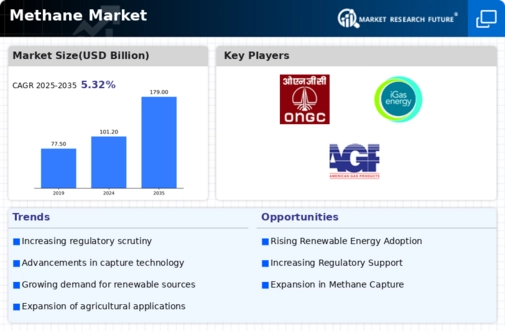Top Industry Leaders in the Methane Market
 Methane, the versatile and abundant molecule at the heart of natural gas, fuels much of our modern world. From powering homes and industries to fueling vehicles and generating electricity, it permeates our lives. But navigating this intricate landscape is no easy feat, with established giants, nimble innovators, and sustainability advocates all vying for dominance. Let's delve into the strategies driving success in this dynamic market, the factors influencing market share, and the recent developments keeping this space abuzz.
Methane, the versatile and abundant molecule at the heart of natural gas, fuels much of our modern world. From powering homes and industries to fueling vehicles and generating electricity, it permeates our lives. But navigating this intricate landscape is no easy feat, with established giants, nimble innovators, and sustainability advocates all vying for dominance. Let's delve into the strategies driving success in this dynamic market, the factors influencing market share, and the recent developments keeping this space abuzz.
Strategies Adopted by Methane Masters:
-
Diversifying Beyond Conventional Sources: Companies like Shell and Gazprom are venturing into unconventional methane sources like coalbed methane and methane hydrates, tapping into vast new reserves and mitigating dependence on traditional pipelines. -
Technological Advancements: Innovation is key, with players like ExxonMobil investing in technologies for cleaner and more efficient production, methane capture and utilization, and liquefaction for easy transportation. -
Geographical Expansion: Emerging markets like China and India are witnessing explosive demand growth. Players like PetroChina and Indian Oil Corporation are strategically expanding their pipelines and distribution networks to capitalize on this potential. -
Environmental Mitigation: Sustainability is a rising tide, with companies like BP prioritizing carbon capture and storage technologies to minimize methane emissions and address climate concerns. -
Renewable Methane Integration: Recognizing the shift towards greener energy, players like Engie and Air Liquide are investing in biogas production from landfills and wastewater treatment plants, offering renewable and sustainable methane options.
Factors Shaping Market Share:
-
Cost Competitiveness: Efficient production processes, access to low-cost methane sources, and optimized transportation and distribution networks influence competitiveness. Players like Gazprom, with their vast domestic reserves, enjoy cost benefits. -
Infrastructure Footprint: Extensive pipeline networks, storage facilities, and LNG terminals facilitate wider reach and market access. Companies like Cheniere Energy, with their strategic infrastructure investments, gain an edge. -
Technological Capability: Companies at the forefront of methane capture, liquefaction, and clean production technologies will command higher premiums and secure valuable contracts. Players like Shell, with their proprietary technologies, stand out. -
Geographical Presence: A strong presence in key demand regions like Asia-Pacific and Europe is crucial. Companies like PetroChina, strategically positioned in high-growth markets, hold an advantage. -
Sustainability Commitment: Implementing carbon capture and storage, investing in renewable methane sources, and demonstrating a commitment to environmental responsibility resonates with environmentally conscious consumers and businesses, giving companies like Engie a potential edge.
Key Companies in the Methane market include
- Oil and Natural Gas Corporation
- Royal Dutch Shell PLC
- Senex Energy Limited
- G3 Exploration
- Black Diamond Energy Inc.
- Halliburton Co.
- IGas Energy
- China National Offshore Oil Company
- China National Petroleum Corporation
- Metgasco Ltd.
- BP PLC
- TLOU Energy Ltd
- Dart Energy Corporation
- Bow Energy
- American Gas Products
Recent Developments
October 2023: Advancements in biogas production technologies are announced by companies like Engie, potentially unlocking new methane sources from organic waste and reducing reliance on fossil fuels.
November 2023: Despite holiday season slowdowns, the methane market experiences steady growth, driven by continued demand from the power generation and industrial sectors.
December 2023: Increasing public and regulatory pressure on carbon emissions leads to a surge in investments in carbon capture and storage technologies for methane production, benefiting companies like Shell and ExxonMobil.









